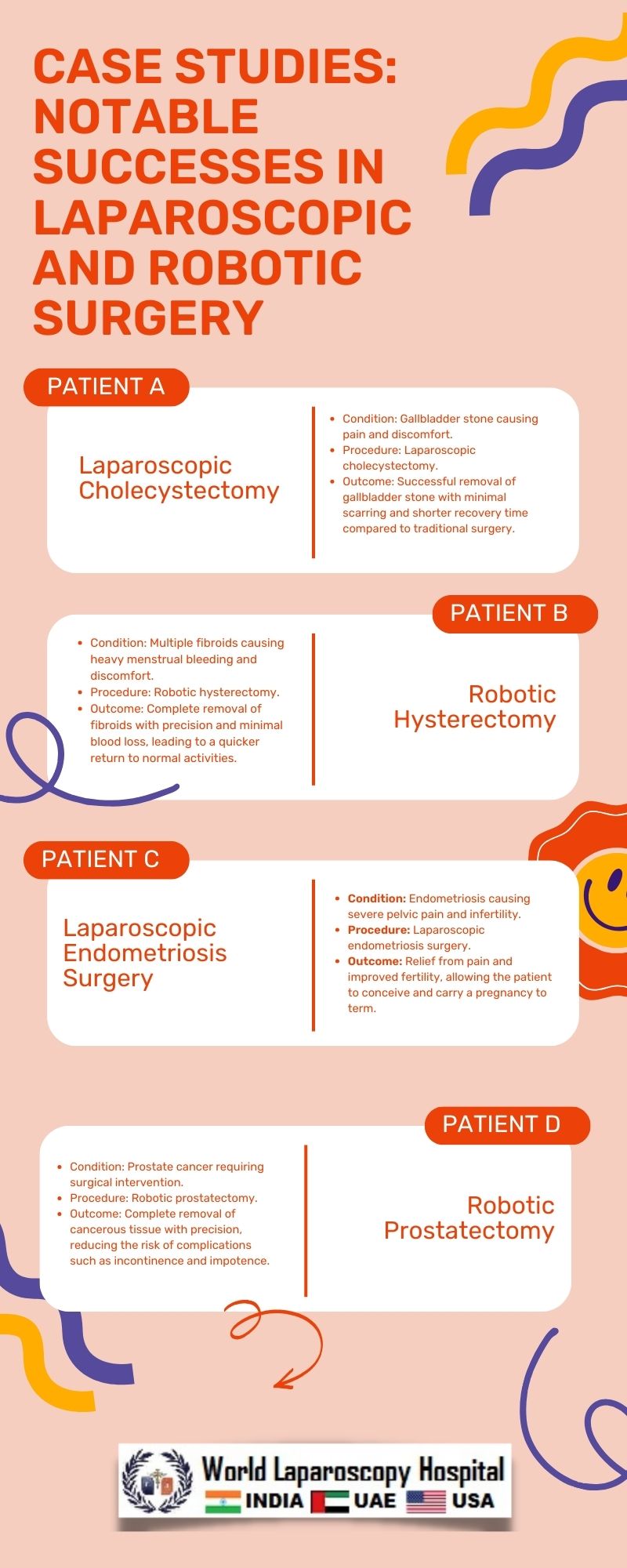Introduction
Laparoscopic and robotic surgery have revolutionized the field of surgery, offering patients minimally invasive alternatives to traditional open surgery. These techniques utilize small incisions and specialized tools, enabling surgeons to perform complex procedures with enhanced precision and faster recovery times. In this article, we explore some remarkable case studies that demonstrate the effectiveness and benefits of laparoscopic and robotic surgery in various medical specialties.

Case Study 1: Laparoscopic Cholecystectomy
Patient Profile
Name: Mr. A
Age: 45
Condition: Gallbladder Stones
Case Description
Mr. A presented with recurrent episodes of abdominal pain, nausea, and vomiting, indicative of gallbladder stones. After a thorough evaluation, he was recommended for a laparoscopic cholecystectomy.
Surgical Procedure
A team of experienced surgeons performed a laparoscopic cholecystectomy on Mr. A. The procedure involved making several small incisions in the abdomen through which a laparoscope and other specialized instruments were inserted. The gallbladder was then carefully removed using these instruments.
Outcome
Mr. A's surgery was successful, with minimal post-operative pain and a shorter hospital stay compared to traditional open surgery. He recovered well and resumed his normal activities within a few days.
Case Study 2: Robotic Prostatectomy
Patient Profile
Name: Mr. B
Age: 55
Condition: Prostate Cancer
Case Description
Mr. B was diagnosed with localized prostate cancer and was advised to undergo a robotic prostatectomy for treatment.
Surgical Procedure
The surgical team used a da Vinci robotic surgical system to perform the prostatectomy on Mr. B. The system provided enhanced 3D visualization and precise movements, allowing for the meticulous removal of the cancerous prostate gland while minimizing damage to surrounding tissues.
Outcome
The robotic prostatectomy was successful, with Mr. B experiencing minimal blood loss and a quicker recovery compared to traditional surgery. He achieved excellent cancer control and preserved his urinary continence and sexual function post-operatively.
Case Study 3: Laparoscopic Nephrectomy
Patient Profile
Name: Mrs. C
Age: 50
Condition: Renal Cell Carcinoma
Case Description
Mrs. C was diagnosed with renal cell carcinoma in her left kidney and required surgical removal of the affected kidney.
Surgical Procedure
A team of urologists performed a laparoscopic nephrectomy on Mrs. C. The procedure involved using specialized instruments to dissect and remove the kidney through small incisions in the abdomen.
Outcome
The laparoscopic nephrectomy was successful, with Mrs. C experiencing minimal pain and a shorter hospital stay. She recovered well and did not require dialysis post-operatively.
Case Study 4: Robotic Hysterectomy
Patient Profile
Name: Ms. D
Age: 40
Condition: Uterine Fibroids
Case Description
Ms. D had symptomatic uterine fibroids and was recommended for a robotic hysterectomy to alleviate her symptoms.
Surgical Procedure
A team of gynecological surgeons performed a robotic hysterectomy on Ms. D using the da Vinci surgical system. The procedure involved removing her uterus and fibroids while preserving her ovaries.
Outcome
The robotic hysterectomy was successful, with Ms. D experiencing minimal pain and a faster recovery compared to traditional hysterectomy. She was able to resume her normal activities within a few weeks and reported significant improvement in her quality of life.
Conclusion
Laparoscopic and robotic surgery have significantly improved patient outcomes and recovery times across various surgical specialties. These techniques offer numerous advantages, including shorter hospital stays, reduced pain and scarring, and faster return to normal activities. The case studies discussed above illustrate the effectiveness and benefits of these minimally invasive surgical approaches, highlighting their role in advancing modern surgical practice.